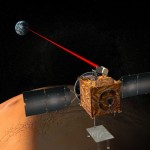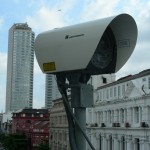THE TITLE OF THIS ARTICLE IMMEDIATELY RECALLS OPTICAL FIBRES AND THE ULTRA-FAST NETWORKS BASED ON THIS TRANSMISSION MEANS, BUT THERE ARE OTHER RISING OPTICAL TECHNOLOGIES THAT WE START CONSIDERING IN TRADE AMBIT, TOO
In 1999, the volume of the voice traffic was surpassed for the first time by the data traffic, which already in 2005 had increased by 4000%, especially due to the exponential growth of internet requests by companies and private citizens for activities like electronic trade, storage applications in Cloud, use of private virtual networks, video conferences, Voice over IP communications, besides other applicative situations deriving from the diffusion of smartphones and tablets. Actually, an acceleration of the demand in global terms of band width, which radiofrequency and optical fibre communications cannot, according to many, satisfy in the future. In the RF case, technologies must come to terms with the available frequency spectrum, while, in the case of optical fibres, cost and also logistics problems intervene, as it is not possible to extend always the connection wherever it would be necessary. The situation is worsened by the consolidation of some trends that will have disruptive effects. The first is the Internet of Things (IoT), which can be defined as a whole of smart machines that interact and communicate with other machines, objects, environments and infrastructures, with generation of enormous volumes of data and their processing to carry out useful actions that can operate and control various entities. In more technological terms, we can speak of an evolution of the machine-to-machine (M2M), of the direct relationship among machines without human intervention, with IP-enabled devices that become integral part of Internet. Other important trend, the Big Data one, big quantities of non-structured or semi-structured data that are created by an organization during its normal activity: e-mails, Word documents, images, audios, films, without neglecting the wide variety of data that present instruments can generate in the ambit of the most various industrial applications, in addition to what comes from Web applications and from Social Media. These data are potentially source of greater competitiveness and productivity, if subjected to the analysis of Big Data Analytics, specific tools suitable for examining big quantities of different data to identify relevant correlations and information. Such an activity implies the handling of big masses of data, also because the operation might be carried out in Cloud, by specialized service providers. The logic conclusion is the following: RF communications can be developed, optical fibres can be multiplied, but undoubtedly other technologies would be welcomed, both as substitutive solutions in some cases and as support in situations of technological mix, and this leads us to new, or better rediscovered, modalities of communicating with light.
Optical fibres and radiofrequency, and not only
As well-known, optical fibre connections assure fast communications on long distances, able to move great quantities of data, and therefore it would be the technology to be used at all costs, but to prearrange a separate optical fibre line for each single user is not always cheap and feasible. And then a technological mix has been conceived, known as “optical wireless”, term with which we refer to the combined use of two technologies to create a telecommunication system: optical fibres as basis and radiofrequency as wireless part (without wire or without cable) of the communication.

Optical fibre connections grant fast communications on the long distance, but it is not always cheap and feasible to prearrange a separate optical fibre line for each single user
Actually, long-distance connections are implemented with optical fibre cables until terminal points, or Local Links, where you have the transformation of optical signals into radiofrequency signals, then received by another Local Link that can diffuse the signal, still in RF modality, towards the end-user, or restore the original optical signal and reintroduce it into the fibres that connect each user. A variant actually exists, where Local Links provide for some laser systems, and in this case the signal that comes from optical fibres is transformed into a laser signal sent to a successive local link where, through photosensitive elements, you achieve the inverse transformation, with the re-input of the information into fibre cables for the use by the end-user. Actually, the optical fibre connection is “interrupted” and for a certain section replaced either by RF communication or by laser light. Over the time different variants of these technological mixes have been defined, and also different versions of technologies based on the transmission of light rays in the free space, in particular Free Space Optical (FSO) Communication and Optical Wireless Broadband (OWB), where even no cables can be present, meaning in our specific case the absence of optical fibre and not of copper cable, hence the more general meaning of “wireless”, that’s to say without cable, whatever it is.
Free-Space Optics
Free-Space Optics (FSO), technology named also Free-Space Photonics (FSP) or LaserCom (Laser Communications), refers to the transmission of a visible light ray or to the infrared one through the atmosphere, to realize broad band communications. It is worth underlining that the concept bases of FSO are not certainly recent: already in 1880 Alexander Graham Bell had devised a Phonofone, a sort of telegraph based on light signals transmitted between two buildings at a distance of about 200 metres each other. The fundamental concepts of the voice and data transmission through light rays have essentially remained in the shadows until in the Sixties military contexts, and not only those of the United States, started being interested in this possible solution for the safe information transmission.

The Free-Space Optics (FSO) technology, where you have the transmission of a visible or infrared light ray, was initially adopted by the military and space context for safe communications
The private sector has then started developing the FSO technology for trade applications only at the thresholds of 2000, anyway also with a certain success, despite the difficulties arising from an inconstant reliability of this communication method, as we will see later on. In the current FSO implementations, light beams emitted by laser are often used, but also non-laser sources can be exploited, for instance LED (light-emitting diode) or IRED (LED that emit infrared light).The theory at the base of the Free-Space Optics is essentially that concerning transmissions in optical fibres, with the difference that the light signal is sent through the ether from source to destination and not confined in a light guide, that’s to say in an optical fibre, hence the definition of “wireless” of this data transmission system based on light. At source level, the light signal is modulated with the data to be transmitted, and at destination the ray is intercepted by a photodetector, with extraction or demodulation of data, followed by the amplification and transmission of information in the form of electrical signals to the user hardware. The operation can be granted on distances of some kilometres, provided that there is a Line Of Sight (LOS) between source and destination; if necessary it is possible to use a system of mirrors to reflect the light, without causing a particularly sensible attenuation. The main drawback of this technology is its sensitivity to rain, dust, fog and smog, conditions that can prevent the correct transmission or reception of signals. To exemplify, a trade free space optics laser link can grant a data rate of 1Gbit/sec until 2Km of distance. As emblematic applications of FSO we can mention two extremes. The first concerns the IrDa standard, from Infrared Data Association), which makes use of infrared radiation for the wireless transmission of data on the short distance, 1 or 2 metres maximum, with typical data rate of 4Mbit/s; this standard was very used for portable computers and other devices, but afterwards it was ousted by Bluetooth, “wireless” standard where this denomination should be meant in the usual sense of the term, referring to RF transmissions and not via copper cable. The second example concerns instead the outer space, beyond the earth’s atmosphere, then space flights, with several applications implemented by NASA on distances exceeding hundreds of kilometres: theoretically, with the use of optical telescopes and special instruments called “beam expanders”, the potential of the FSO technology in this ambit exceeds millions of kilometres. In general, the present market interest in the FSO technology springs from the possibility of using a carrier frequency up to 300 Terahertz (1 Thz = 1 000 000 000 000 of Hz), from which derives a really big band width, to the extent of allowing data rates of several Gbps, up to 40 Gbps according to the most recent estimates. Finally, as further positive feature we should mention the possible combination of FSO and optical fibres, giving birth to mixed systems without needing any intermediate conversion of signals.
Optical Wireless Broadband (OWB)

The current OWB systems can transmit voice, videos and data at 100 Mbps and at 1.25 Gbps, on optimal distances from 500m to 2Km
This technology represents the new generation of “optical light technology”, evolution of the Free-Space Optics of which it is the current state of the art. To exemplify the present trade possibilities, one of the sector leader producers, the company Skyfiber, proposes systems that can transmit voice, videos and data at 100 Mbps and at 1.25 Gbps, and in the short term the release of the new versions at 2.5 Gbps and at 10 Gbps is planned, value, the latter, thousands of times higher than the speed of a normal DSL connection. It is worth underlining that, thanks to innovations both in the hardware and in the software field, we have reached levels of operational reliability that it was not possible to grant with the previous FSO. Operationally, OWB systems work in the same way as an optical fibre cable: at a terminal, the one on the transmission side, the system is connected with an optical fibre cable where data are input in the form of light signals; afterwards, you have the transmission of the “light beams” of visible or infrared light in the spectrum of Terahertz, with successive focusing at destination through lenses connected by optical fibres to high-sensitivity receivers. At this stage information can go on travelling in fibre towards user stations or undergo a conversion into radiofrequency signal according to WiFi modalities, and reach end-users. OWB solutions are very versatile, since they can be installed both indoor and outdoor, and in this case on the roofs of buildings or on towers prearranged to that purpose. Currently the optimal distance for a carrier-grade OWB system ranges from 500m to 2Km, but applications of point-to-multipoint or mesh type are not missing, where with structural solutions based on reflecting elements you can expand the signal coverage. Considering that light beams are not generally constituted by laser light, a question concerning safety arises naturally. As well-known, lasers are subdivided into classes, from 1 to 4, with powers from 0.04mW (completely harmless) to more than 500mW (for instance, industrial lasers used for the metal cutting). Trade OWB products are granted as safe, both for human eye and the environment, and it might not be different. Moreover, some analysts have identified in this technology some aspects that make it “environmentally friendly”, finally greener than others, because optical fibres for the transfer of the light signal from source to destination are necessary only in the initial and final parts of the section, hence the minor use of materials and construction processes, and it is possible to do without RF transmissions, or to use them just as choice at the destination site for the diffusion of the signal to the foreseen users, thus eliminating any form of electromagnetic pollution. Referring to the transmission protocols of information, all Optical Wireless Broadband products can be integrated into whatever net, as it is possible to transmit according to the Ethernet, Fast Ethernet, Gigabit Ethernet, SONET/SDS standards, but also ATM (Asynchronous Transfer Mode), and FDDI (Fiber Distributed Data Interface), specific type of network based on the use of optical fibres as transmission means. Besides, they were not missing applications in which the technology has been used by extension of existing nets and for DWDM (Dense Wavelength Division Multiplexing) services, methodology that allows increasing the available band quantity on an optical fibre channel, with transmission on the same fibre of more optical signals with different wavelengths, with a frequency modulation that permits the data transport on each wavelength in independent way. We talked before about the better reliability of OWB solutions in comparison with the previous FSO. Since the transmission “means” is the same, that’s to say air or free space, in both cases the critical solutions are actually the same: bad weather conditions with rain and fog. These criticalities can be mostly mitigated with an accurate net planning, for instance by adding a redundancy, concept that is well-known in engineering and that can be synthesized in the duplication of critical elements of a system to enhance its reliability and availability. In the OWB case a redundancy solution provides for the use of RF stations with backup microwaves, which intervene when the light connection falls due to the weather.




